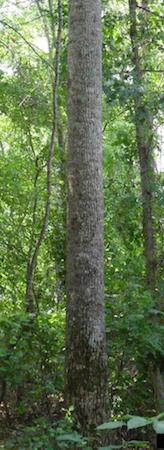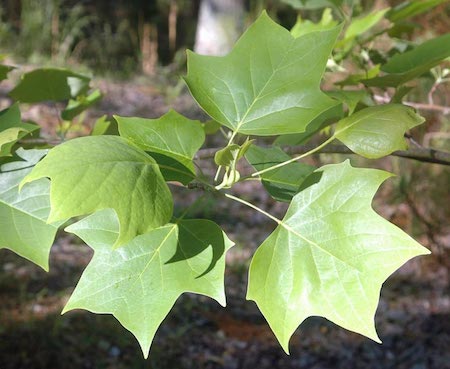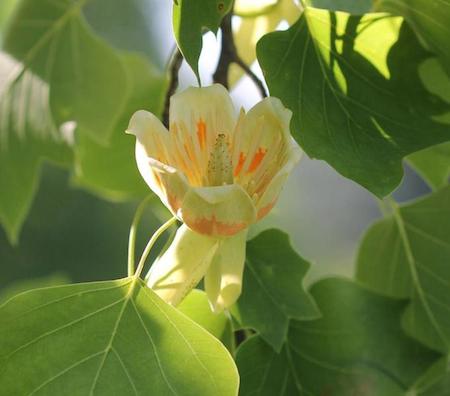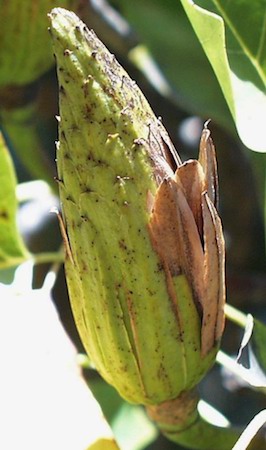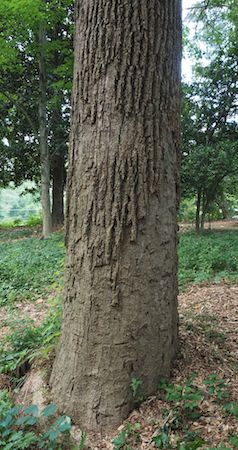Tulip
Specifications
- Also known as: Tuliptree, Tulip Poplar, Yellow Poplar
- Latin (scientific) name: Liriodendron tulipifera. Tulipfera is Greek for lily and tree, for its lily-like or (better put) tulip-like flowers.
- Life expectancy: 400 years
- Height: 135 feet
- Circumference: 19 feet
-
The height and circumference measurements listed here are for the largest-known tulip tree in Atlanta. It also qualifies as a co-state champion. This tree is located on private property in Peachtree Park.
-
Special characteristics:
This tree is not a poplar tree as the name implies; it is the king of the Magnolia family! It’s the tallest hardwood in North America and a fast growing tree, too. They are also the straightest trees in your yard or in a forest, which makes them easy to identify.
When the leaves first come out they are a pale green, a much brighter green than other species of trees. They turn a deeper green in summer and give a surprise appearance of rich yellow on a few select leaves (about 1/3 total foliage) well in advance of any other tree turning color.
The flowers are a real show-stopper. They are about the size of a tulip (hence its namesake) from 1.5 to 2 inches deep. They are yellow or orange at base and light greenish shade above. Stunning! The odor they produce is sweet and appealing. Most folks never figure out where the sugary smell comes from because the blooms are so high up in the tree. The blooms attract a lot of pollinating insects and you can actually hear the tree hum with activity on a still day.
As the trees grow, they begin to shed the bark at the base of the trunk. This is a natural process, and does not mean that the tree is sick.
-
Annoyance factors:
These trees throw off alot of debris, starting with leaf litter. Leaves begin to fall very early, in late summer. The tree loses about one-third of its foliage well before any other tree starts to drop leaves. This alarms many people, who worry that their tree is dying. It’s not. If the leaves are bright yellow, there is no reason to be concerned.
In winter, this tree releases large amounts of winged seeds. They aren’t big, but there are a lot of them.
The dead wood of a tulip tree is soft; it will get dropped by the tree more quickly than other species. The bark is thick and corky. If you have this tree cleaned out of dead wood, make sure the climber uses a branch saver on his rope to protect the bark from damage.
-
Fun Facts:
The wood and twigs have a sweet aromatic smell, just like the Southern magnolia tree. Snap a twig and take a sniff. Ahhhhhhhh! If only it could be bottled: Eau de Tuliptree.
The wood is light in weight, easy to cut, and very easy to work. It’s a very important commercial timber tree with many uses. Settlers used to carve it out for canoes. Story says Daniel Boone made his canoes using this tree.
The wood turns a different color when it is hit by lightning. After a year, lightning-struck tulip trees change from pale green to a multi-color of black, pink, violet, and orange -- gorgeous! This unusual wood is highly sought by wood turners for its color and natural workability.
-
Photo Credits:
Tree: David Stephens, Bugwood.org
Bark: Peter Jenkins, Tree Inspection.com
Leaves: Chris Evans, Illinois Wildlife Action Plan, Bugwood.org
Flowers: Steven J. Baskauf, Vanderbilt University Bioimages
Seeds: Paul Wray, Iowa State University, Bugwood.org

